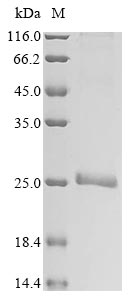Amino acids 23-212 constitute the expression domain of recombinant Human PLAC1. This PLAC1 protein is theoretically predicted to have a molecular weight of 23.3 kDa. This PLAC1 recombinant protein is manufactured in e.coli. The PLAC1 gene fragment has been modified by fusing the N-terminal 6xHis tag, providing convenience in detecting and purifying the recombinant PLAC1 protein during the following stages.
Human placenta-specific protein 1 (PLAC1) is a protein primarily associated with placental development and function. PLAC1 is expressed predominantly in the placenta, specifically in trophoblast cells, indicating its role in fetal-maternal interactions. PLAC1 is implicated in key processes such as trophoblast invasion, a critical step for successful implantation and placental development. Aberrant PLAC1 expression has been observed in certain pregnancy-related disorders, suggesting its potential relevance as a biomarker or factor in complications like preeclampsia.






